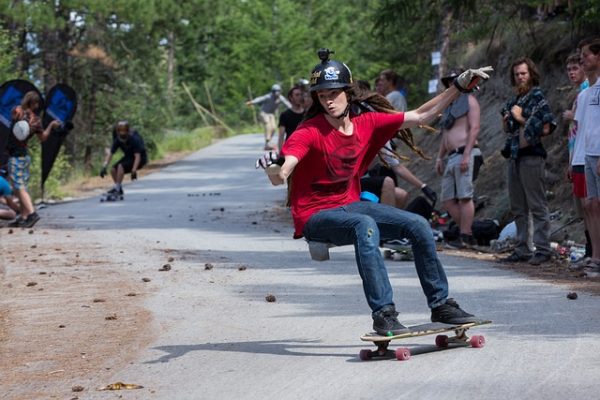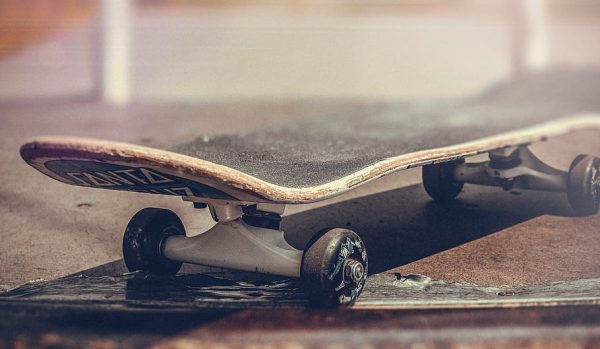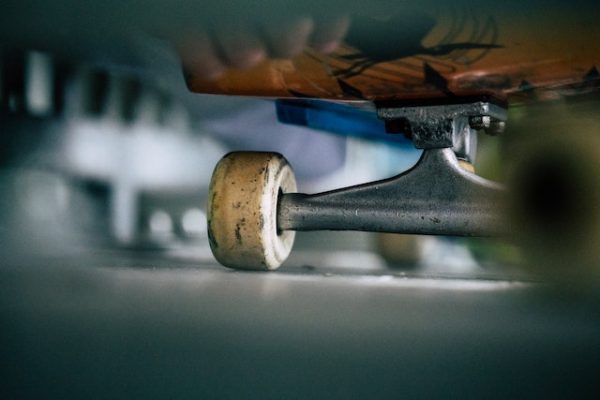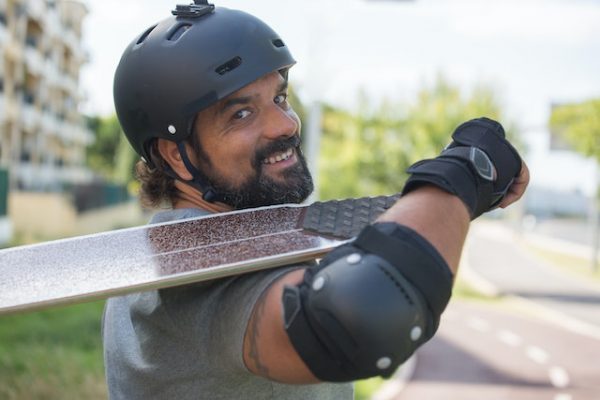Skateboarding, the adrenaline-pumping sport that has captured the hearts of millions worldwide, is more than just a hobby; it’s a thrilling way of life. The feeling of wearing gear, gliding on a skateboard, the wind in your hair, and the freedom to explore the urban landscape is an experience unlike any other.
Whether you’re drawn to skateboarding for its artistic expression, competitive edge, or simply looking for an exhilarating form of recreation through skating, one thing remains constant: the importance of beginner’s skating gear.

This article is your ultimate companion on your journey to becoming a confident and skilled skateboarder. We understand that stepping onto a complete skateboard for the first time can be intimidating, but fear not! Our step-by-step guide will equip you with the essential knowledge, gear, and techniques you need to start rolling with confidence. Think of it as your skateboarder’s menu, offering a variety of tips to help you master the basics of skateboarding.
From choosing the right high-quality deck and understanding the mechanics of trucks and wheels to mastering the basic riding stances and beginner-friendly tricks, we’ve got you covered. Safety is paramount, and we’ll emphasize the importance of protective gear and maintaining a responsible approach for your riding adventures.
Key Takeaways
- Safety First: Always wear a skating helmet and protective skating gear to prevent skating injuries.
- Choose The Right Skateboard: Boards come in different shapes and sizes. Find a skating deck that suits your size, weight, and skating skill level.
- Practice Balance And Pushing: Get comfortable skating standing with a gear on the skateboard and pushing off to generate speed.
- Master Turning And Tic-Tacs: Learn to steer your best skateboard and make small pivoting movements while keeping yourself safe with gear.
- Start With Beginners’ Tricks: Begin with skating ollies, skating kick turns, and skating manuals to build your skills.
- Stay Persistent And Patient: Improvement takes time and practice; don’t get discouraged. Just wear skating gear.
- Observe And Learn From Others: Skate with experienced skateboarders to pick up valuable tips.
- Embrace The Skateboard Riding Community: Connect with other skaters at skate parks and follow park etiquette like wearing safety skating gear.
A Complete Guide To Beginner Skateboarding Gear
Riding your board is an exciting and popular sport for people of all ages. If you’re a newbie looking to get started, having the right tools is essential for safety and a smooth learning experience. Essential gear, including protective tools, is crucial for a new rider starting with their first board. Here’s a list of essential gear for newbies:

Skateboard Deck
Obviously, the first thing you’ll need for yourself is a complete skateboard. Some typically start with a standard deck, which is usually around 8 inches wide. You can choose from various brands and designs, but make sure it’s of good quality and suited for you.
Skateboard Trucks
Trucks are the metal T-shaped components that attach to the underside of the skateboard deck. They allow you to turn and maneuver the board. For some, it’s good to go with mid-range trucks that match the width of your deck.

Skateboard Wheels
Skateboard wheels come in different sizes and hardness levels (durometer). For some, softer wheels (78A-87A durometer) are recommended as they provide better grip and a smoother ride, making it easier to learn the basics.
Skateboard Bearings
Bearings are essential for allowing the wheels to spin smoothly on the axle of the trucks. For good quality, bearings will make your ride more enjoyable and efficient.
Skateboard Grip Tape
Grip tape is a gritty, sandpaper-like material that goes on top of the skateboard deck. The grip tape provides traction and helps you maintain control of the board while riding. The grip tape allows secure footing while you maneuver your board. Without a grip tape, you can easily slip off your skateboard which may harm you.
Helmet For Skateboarding
Safety should always be a priority, especially for newbies. Since helmets can be of different shapes and sizes, a well-fitted helmet is essential for your protection in case of falls or accidents.

Skateboard Protective Gear
As a newbie, you’re likely to experience some falls while learning new tricks. Consider wearing knee pads, elbow pads, and wrist guards for your protection from bruises and injuries.
Skate Shoes
Proper skateboard riding shoes are designed with durable materials and grippy soles to provide better control and protection while riding. Regular sneakers might wear out faster due to the abrasive nature of the grip tape.
Clothing For Riding
Wear comfortable and flexible clothing to move freely while skateboard riding. Avoid loose clothing that may get caught in the skateboard’s moving parts.
Skate Tool
A skate tool is a small, versatile tool for you to adjust your skateboard’s trucks and wheels easily. It’s handy for on-the-go adjustments. Remember, safety comes first, so always wear your helmet and protective equipment while skateboarding for safety. As you gain more experience and confidence, you can start exploring other skateboard riding accessories and equipment. Happy skateboarding!
Essential Skateboarding Equipment For Beginners
For a beginner skater, riding might be wondering about some accessories that can enhance your experience and make your skateboard riding journey more enjoyable.
The best skateboard riding tips include getting the right equipment, such as a skate helmet, or equipment for beginners (consider a complete skateboard from different brands). Features like flat soles for more stability and harder wheels can focus on learning tricks while ensuring you have the right tool.
Other Must-Have Skate Accessories
While the essential tools like a skateboard, helmet, and protective pads are a must, here are some additional accessories for your skateboard riding adventures:
- High-Quality Skateboard Riding Backpack: A durable and spacious skater backpack can be incredibly useful for carrying your skateboard, water bottle, extra clothing, gear, and other skating essentials while you’re out and about exploring skate spots or heading to the skate park.
- High-Quality Skateboard Wax: Skateboard wax is a small but handy skating gear for ledges, skate rails, and skate curbs to make it more slippery. It helps reduce friction, making it easier to slide and grind on various skate obstacles.
- High-Quality Bearing Lubricant: Keeping your skateboard bearings clean and well-lubricated is essential for smooth and efficient riding. A bearing lubricant will help extend the life of your bearings and maintain optimal performance.
- High-Quality Skateboard Deck Rails: Deck rails are plastic strips that can be attached to the sides of your skateboard deck to protect it from wear and tear caused by tricks like board slides and grinds.
- Skateboard Lock: If you plan to skateboard around town and might need to leave your board unattended for a short while, a skateboard lock can provide peace of mind, helping to deter theft.
- Skateboard Tool: A skate tool is a compact device that allows you to adjust the tightness of your skateboard trucks and wheels on the go. It’s a must-have for making quick adjustments during your sessions.
- GoPro or Action Camera Mounts: Capture your skateboard skate tricks and experiences by mounting a GoPro or action camera to your skateboard or helmet. Reliving your best moments and sharing them with others can be incredibly rewarding.
- Skateboard Ramp or Rail: If you have some space at home or in your backyard, consider getting a small skateboard ramp or rail to practice and improve your skills. These portable ramps are great for honing your tricks.
- Portable Speaker: Skateboard skating is even more enjoyable with your favorite tunes. A small, portable speaker can add a fun element to your skate sessions with some music.
- Skateboard Stickers: Personalize your skateboard and express your style by adding stickers on your skate gear, from your favorite skate brands or skating artists. They can add character to your skateboard and make it uniquely just for you.
Remember, while these accessories can enhance your skateboard skating experience, safety should always be your top priority. Always wear your helmet and protective gear, and skate within your skill level for safety and protection. Enjoy the ride and have fun exploring the world of best skateboard riding!
New Skateboarders Safety And Maintenace Tips
Congratulations on taking the first steps into the exciting world of skateboard skating! As a beginner, it’s normal to feel overwhelmed, but with practice and dedication, you’ll quickly improve. Here are some essential skateboard riding tips to help you get started and progress in your skateboard riding journey:
- Safety First: Always wear a helmet, knee pads, elbow pads, and wrist guards when skateboard riding. Safety gear is crucial in preventing serious injuries, especially as you’re learning new tricks and techniques.
- Find a Suitable Skateboard: Since skateboards are of different shapes and sizes, choose a skateboard that suits your size, weight, and skill level. A wider and more stable skate deck is generally built better for beginners, but ultimately, go with what skateboard feels comfortable for you.
- Practice Your Stance: Determine if you’re more comfortable with a regular skateboard stance (left foot forward) or a goofy stance (right foot forward). Experiment with both to see which feels natural to you.
- Learn to Balance: Start by placing your skateboard on a flat surface and practice standing on it. Get comfortable with your skateboard balance and body weight distribution before attempting to ride.
- Master the Push: Learn to push off the ground with one foot on the skateboard while keeping the other foot on the skateboard. This is the basic way to generate speed and momentum.
- Practice Riding: Find a smooth and flat area to practice skating. Focus on maintaining your balance and pushing smoothly. Gradually increase your skate speed and get used to turning on the skateboard. With constant practice, you will be close to being a pro in no time.
- Weight On The Right Foot: The primary principle is to consistently maintain your weight on your front foot. The front foot can be the right or left foot. The front foot faces the direction you are going. When skating over flow or tricky slopes, transfer your weight to the front foot.
- Get Comfortable with Tic-Tacs: Tic-tacs are small pivoting skating movements that allow you to turn while standing still. They are essential for maneuvering on the skateboard.
- Learn to Turn: Once you’re comfortable skating in a straight line, practice making gentle turns when skating. Lean in the skateboard direction you want to turn and use your feet to steer the skateboard.
- Start with Basic Tricks: Begin with simple tricks like skateboard ollies, skateboard manuals, and skateboard kick turns. These best skateboard tricks will help you understand the mechanics of the skateboard and improve your overall control.
- Stay Relaxed and Focused: Skateboard riding can be challenging but don’t get discouraged. Stay relaxed, focused, and patient with yourself when skating. Like any skill, great improvement takes time and practice.
- Use Proper Foot Positioning: Pay attention to your foot positioning while attempting skating tricks. It can greatly impact your skating balance and skating control.
- Learn from Others: Observe and skate with more experienced skateboarders. You can pick up valuable skating tips and skating trick ideas by watching how they ride and approach skating obstacles.
- Stay Persistent: Skateboard riding can be tough at first but don’t give up. Keep pushing yourself to try new things and improve your skating skills. The more you skate, the better you’ll get in skating.
- Respect Skate Park Etiquette: If you’re at a skate park, be aware of other skaters and follow the park’s rules and etiquette. Wait for your turn and be considerate of others.
- Remember, skateboard riding is all about having fun and expressing yourself. Enjoy the process, and don’t be afraid to challenge yourself. With time and dedication, you’ll become a more confident and skilled skateboarder. Happy skateboarding!
Features Of The Best Beginner Skateboards
As a beginner in skateboarding, you need a complete skateboard with an appropriate deck width, and smooth surfaces to practice on, as these are the important equipment for starting. Also, you’ll need a skateboarding deck, trucks, wheels, and bearings. Skateboarding decks come in various sizes and shapes, so choose one that suits your preferences.
Additionally, make sure to invest in the best skateboard tools, like elbow and knee pads, as well as a helmet, for protection while learning and practicing new tricks. These essential protective equipment items will help keep you safe and confident as you embark on your skateboarding journey.
Conclusion
Skateboarding is a thrilling and dynamic sport that offers endless possibilities for self-expression, creativity, and personal growth. As a beginner, you’ve embarked on an exciting journey filled with challenges and triumphs. By following the essential tips we’ve covered, you’ll be well on your way to becoming a proficient skateboarder.
Safety should always be your top priority. Always wear your helmet and protective gear, as they are the keys to preventing serious injuries and ensuring a long-lasting skateboarding experience. Mastering the basics, such as balancing, pushing, and turning, will serve as a solid foundation for your future progress.
Frequently Asked Questions
What Do Beginners Need To Start Learning How To Skateboard?
You need a skateboard with the right board size, hard wheels, regular shoes, and a parking lot to practice, along with a beginner’s guide for guidance. Also, certain skateboard elements are required when you shop, but they can vary based on personal preference. One essential aspect is to wear protective gear for your safety, such as helmets, and knee and elbow pads, to ensure safety while learning and performing skateboarding tricks.
Having the right skateboarding equipment is crucial, which includes your skateboard, chosen based on your skateboarding level, like a beginner skateboard for beginners. Skaters can access local skate parks or suitable skateboarding spots. This allows them to practice and improve their skills in an environment with support and enjoyment.
What’s The Best Way To Practice Skateboarding?
When learning to skateboard, practice safety standards, spend time practicing, and gradually try different terrains. When learning to skateboard, beginner skateboarders should focus on fundamental skills before attempting advanced tricks. Begin by mastering the basics of skate riding, skate turning, and skate stopping on your beginner skateboard. Work on getting comfortable with your front foot positioning and skate balance while pushing. Remember, practice skating regularly and be patient with yourself as you build a solid foundation and have skateboarding endeavors.
How Can I Practice At Home Without My Own Skateboard?
Practicing skateboarding at home is possible with some creative approaches. You can practice skateboard riding at home by using your own cruiser skateboard with soft wheels. Wear protective gear and make sure to wear skate shoes so you will be safe.
Is It Possible For Me To Practice Riding A Skateboard Alone?
You can practice alone in street skating with a complete skateboard featuring medium-sized wheels, but remember that helmets protect. Practicing skateboarding alone requires careful preparation and safety measures. Find a suitable location with a smooth ride to reduce the risk of accidents. Always wear a helmet in case of falls or collisions. Consider using wrist braces, which are vulnerable to injuries while riding.
What Should I Avoid Doing When Learning How To Ride A Board?
When skating, there are certain things you should avoid to ensure your safety. Firstly, never skate without wearing a helmet. Of course, avoid riding skateboards made from questionable materials like aluminum alloy, as they may lack the necessary flexibility and durability.
How Do You Not Get Hurt When Practicing?
For skating safety and to avoid getting hurt when skating, it’s important to follow some safety guidelines. Firstly, progress in skating at your own pace and don’t attempt tricks or maneuvers beyond your skating skill level. Invest in a new skateboard that suits your riding style and skill level, as worn-out or improper equipment can lead to accidents.
Additionally, practice regularly for you to gain more control over your skateboard, and focus on mastering fundamental skating skills before moving on to advanced skating tricks. Lastly, always wear proper skating protective gear, such as skate helmets, and knee and elbow pads to reduce the risk of injuries while skating.
Do Girls Find It More Difficult To Ride?
Skateboard beginners may find it hard to ride at first. Skateboarding difficulty is not inherently gender-specific. Both skater boys and girls can face challenges when learning to skateboard, but it ultimately depends on individual factors such as physical ability, practice, and skate dedication. While there might be social and cultural factors that historically led to fewer girls participating in skating especially for beginners, the landscape is changing, and more girls and women are becoming prominent figures in skating.
What Size Board Is Best For A Beginner?
What Is The Most Common Injury In Skateboarding?
Why Should I Have Complete Tools When Practicing?
Last Updated on July 6, 2024 by Jeanne Meets
DISCLAIMER (IMPORTANT): This information (including all text, images, audio, or other formats on FamilyHype.com) is not intended to be a substitute for informed professional advice, diagnosis, endorsement or treatment. You should not take any action or avoid taking action without consulting a qualified professional. Always seek the advice of your physician or other qualified health provider with any questions about medical conditions. Do not disregard professional medical advice or delay seeking advice or treatment because of something you have read here a FamilyHype.com.